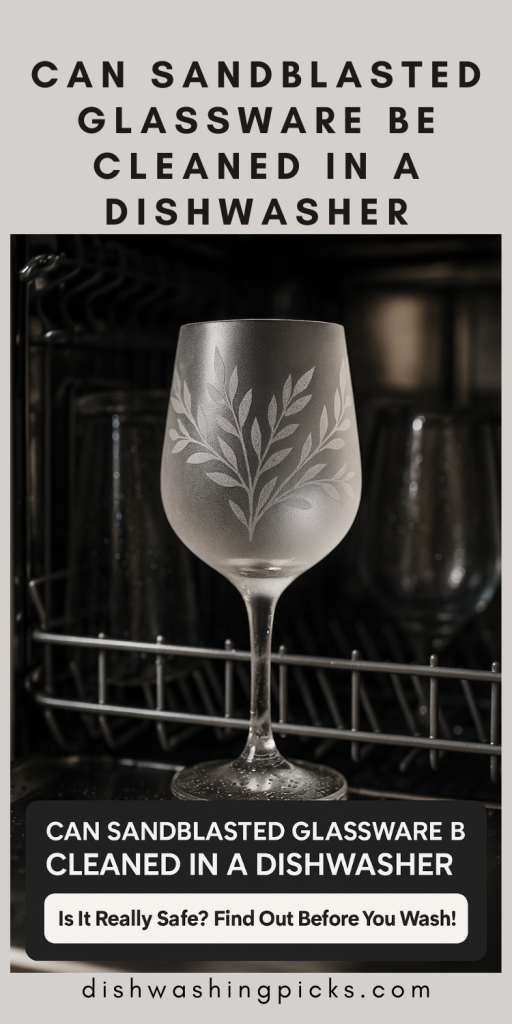You just hosted a low-key dinner party—great food, even better wine, maybe a few “accidentally deep” conversations—and now you’re staring at a pile of dirty dishes. Your fancy sandblasted glasses are part of the mess, and you’re hit with a classic internal debate:
“Can I just toss these in the dishwasher and call it a night?”
I mean, they’re glass, right? And dishwashers are literally made to clean glassware. But these aren’t just any glasses—they’re etched, frosted, sandblasted beauties that probably made your guests go, “Ooh, fancy.”
So now you’re torn between convenience and caution. Been there.
Let’s unpack this a bit, shall we?
Wait—What Is Sandblasted Glassware, Anyway?
Great question, glad you asked. (I knew we were gonna get along.)
Sandblasted glassware is exactly what it sounds like: glass that’s been hit with a high-speed stream of abrasive material—usually sand or a similar grit—to create a frosted or textured design. It’s like giving plain glass a little personality. Think monograms, floral patterns, custom logos, artsy swirls—you get the vibe.
Now, here’s the kicker: that design? It’s not just printed on the surface. It’s etched into the glass. Which means it’s a bit more delicate than regular ol’ drinkware, and it can be affected by heat, harsh detergents, and aggressive jets of water.
Still thinking, “So… dishwasher? Yay or nay?”
We’re getting there—next up, let’s talk about what dishwashers actually do to your beloved sandblasted glasses, and whether it’s worth the risk.
What Does the Dishwasher Do to Sandblasted Glassware?
Okay, imagine this: your sandblasted glassware is living its best life in your dishwasher. But what’s actually happening behind the scenes? You’ve got high heat, powerful water jets, and a bunch of abrasive dishwashing detergent all working together to clean your glasses. Sounds effective, right?
But here’s the thing: sandblasted glass is a bit more vulnerable than your average glassware. That etched design, while gorgeous, isn’t as durable as a regular glass surface. The dishwasher’s heat and aggressive wash cycle can actually wear down those delicate etchings over time, leading to fading, scratching, or even damage to the design itself. Yikes, right?
What Could Go Wrong?
- Fading of the Sandblasting: The combination of high heat and harsh detergent can cause the frosted finish to fade or become uneven. Imagine putting your favorite shirt in the dryer a few times too many—the color just doesn’t look the same anymore. Same idea here.
- Scratches & Chips: Your sandblasted glass might have the occasional bump in the dishwasher (especially if it’s next to heavier items like pots or plates). That can lead to scratches on the design or even chips in the glass itself. Not exactly the look you want when you pull out your glassware for a special occasion.
- Discoloration: Sometimes, the detergent used in dishwashers can react with the frosted finish and leave a weird, cloudy appearance. It’s like when your clear glasses start looking a little too… milky? Yeah, not cute.
Can You Avoid These Issues?
Of course, there are ways to make it less risky—but the truth is, it’s still a gamble. If you’re set on using the dishwasher, here are a couple of tips to help minimize potential damage:
- Top rack only: Always, and I mean always, place sandblasted glassware on the top rack. This keeps it farther from the heating element at the bottom, where temperatures can get more intense. It’s like giving your glass a comfy, cool seat in the back of the bus.
- Use a gentle cycle: If your dishwasher has an option for a “delicate” or “glassware” cycle, use it. This will reduce the heat and intensity of the wash cycle, which can help protect your sandblasted pieces.
- Skip the harsh detergent: Some dishwashing detergents are more abrasive than others. Go for a gentler, milder detergent to reduce the risk of damage. (And bonus points if it’s eco-friendly—double win!)
But here’s the big takeaway: Even with all these precautions, there’s no guarantee your sandblasted glassware will come out of the dishwasher unscathed. You could be taking a risk, especially if those glasses have sentimental or monetary value.
So, what’s the best alternative?
How to Clean Sandblasted Glassware Safely (Without the Dishwasher Drama)
So, if you’ve decided that putting your precious sandblasted glasses through the dishwasher isn’t worth the gamble (and let’s be real, it’s probably not), don’t fret. There’s a much safer, gentler way to keep them looking brand new. Here’s how you can clean them by hand—without any drama.
🧼 Handwashing Is Your Friend
I know, I know—handwashing sounds like extra work when you’ve got a whole sink full of dishes. But for your sandblasted glassware, it’s the safest option by far. Here’s the deal:
- Use Warm Water, Not Hot: Keep the water temperature moderate. Too hot, and you could risk damaging the finish. Too cold, and it might not clean as effectively. Find that sweet spot.
- Mild Dish Soap: Avoid anything with harsh chemicals or strong fragrances. Go for a gentle dish soap—something that’s tough on grease but soft on your delicate glass. It’s like using a facial cleanser that won’t strip your skin!
- Soft Sponge or Cloth: You need to use a non-abrasive cloth or a soft sponge. This will ensure that you don’t scratch or damage the sandblasted design. Think of it like petting your glassware gently after a long day—nothing too rough.
- No Scrubbing: Seriously. Just gently wash the glass with the sponge. The sandblasted design is delicate, and scrubbing could wear it down. Patience is key!
- Dry Gently: Once you’ve cleaned them, don’t just let them air dry and hope for the best. Instead, gently towel-dry them with a soft cloth to avoid water spots and streaks. (Trust me, it’s totally worth it.)
Are There Any Time-Saving Alternatives?
If you’re thinking, “I don’t have time to handwash every glass, every time,” I totally hear you. Maybe you’ve got a few fancy pieces you want to keep nice for special occasions—but what about the rest? Here’s what you can do:
- Protective Cases or Racks: Consider getting a protective glass rack or storage case that helps shield your sandblasted glassware from knocks, bumps, and accidental scrubbing. It’s like a little security system for your glasses—without the alarm.
- Limit Dishwasher Use to Non-Sandblasted Glasses: If you’ve got both regular and sandblasted glasses, consider only putting the plain ones in the dishwasher. That way, you’re still getting the convenience of the dishwasher without risking your decorative glassware.
Final Thoughts: Handle with Care
At the end of the day, the best way to preserve your sandblasted glassware is to treat it with the same care and attention you’d give to any cherished item. Sure, it’s tempting to let the dishwasher do the work, but a little extra time and care when cleaning will ensure those beautiful etchings last for years—and still impress your guests with every use.
Imagine this: You pull out your sandblasted glassware for a special occasion. They look as pristine as the day you got them. Your guests admire the craftsmanship. You smile because you knew it was worth the extra effort.
It’s a win-win. And hey, those glasses are going to look amazing with whatever cocktail you decide to serve next.

